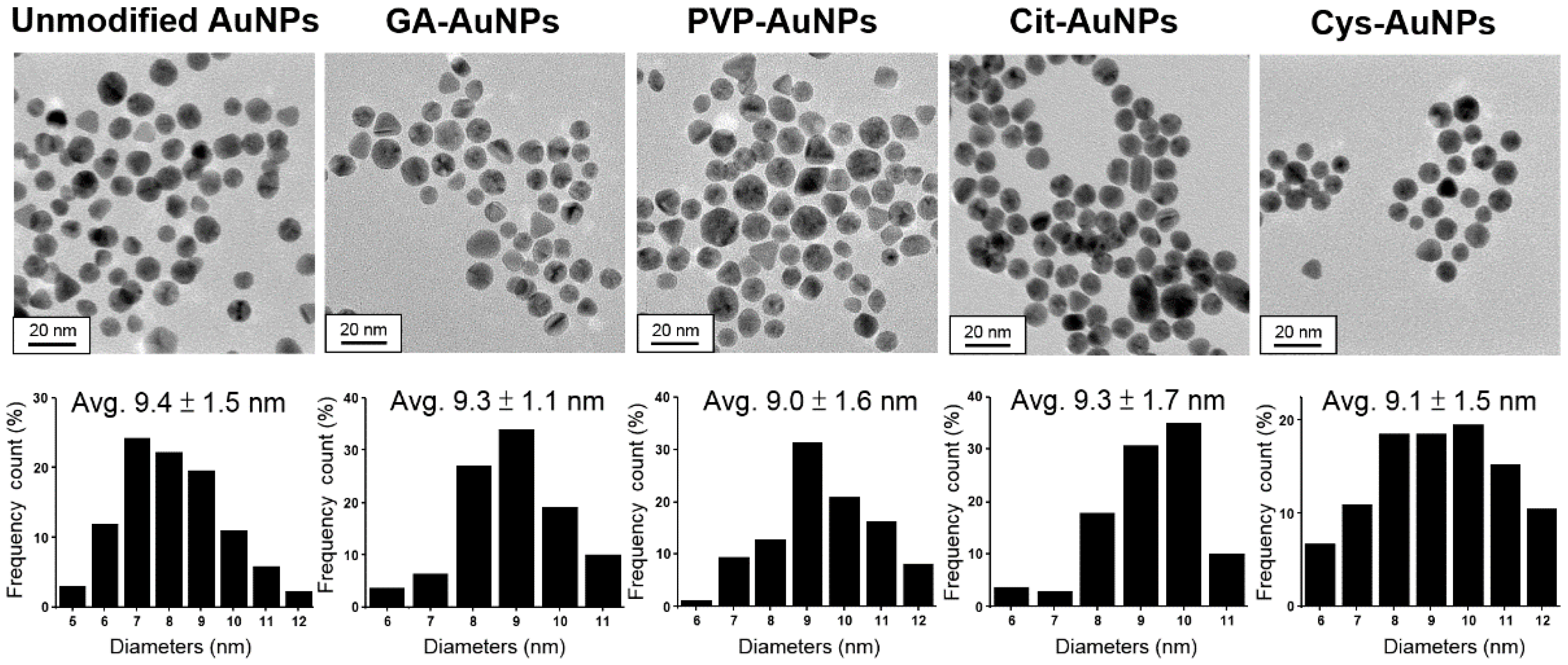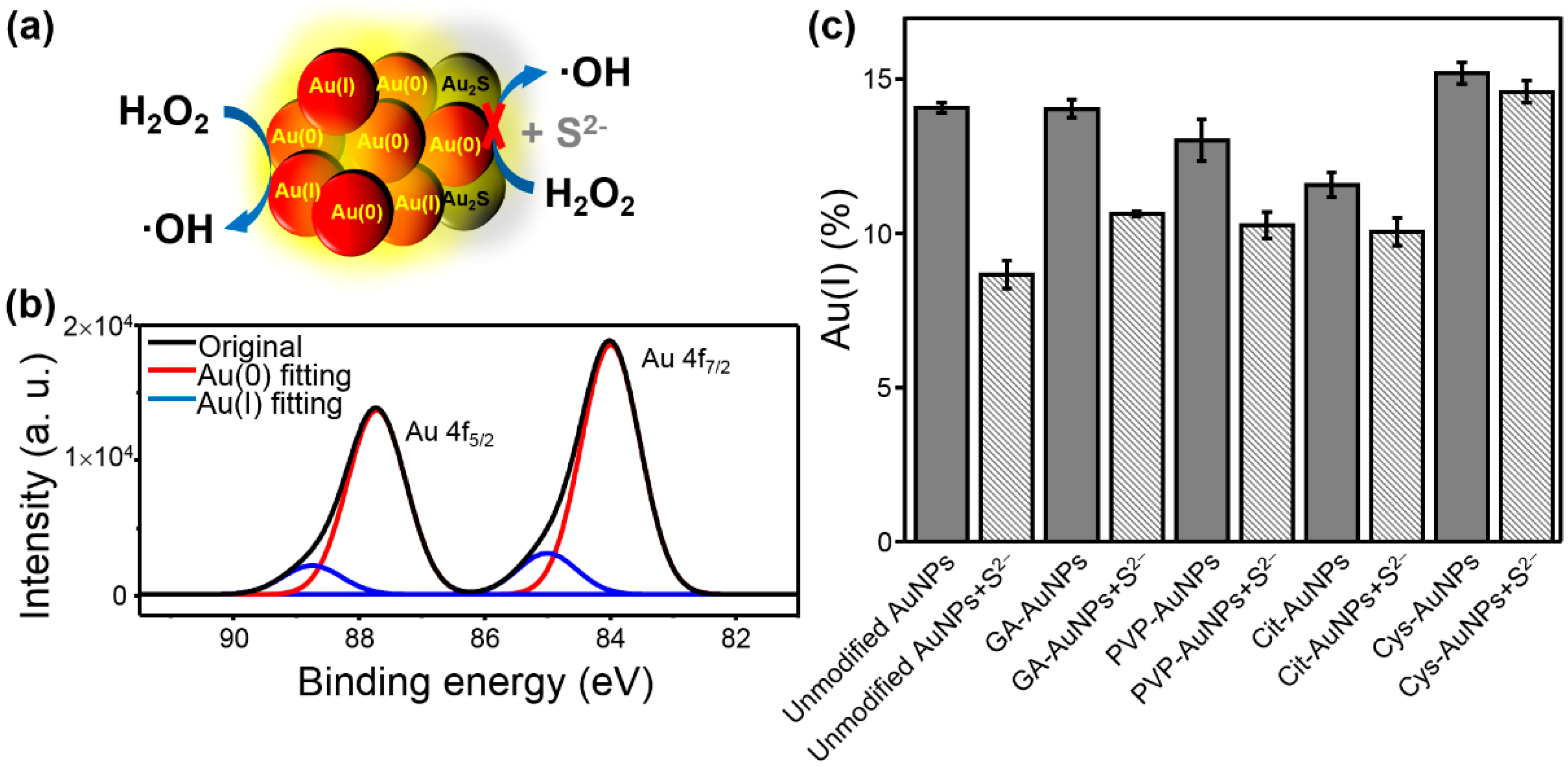Revealing the Active Site of Gold Nanoparticles for the Peroxidase-Like Activity: The Determination of Surface Accessibility
Abstract
1. Introduction
2. Results
2.1. Characterization of AuNPs
2.2. XPS Measurements of AuNPs without and with S2− Addition
2.3. Comparison of the Peroxidase-Like Activity of Different Surface-Capped AuNPs
3. Discussion
4. Materials and Methods
4.1. Chemicals
4.2. Preparation of Different Surface-Capped AuNPs
4.3. Characterization
4.4. Examination of the Peroxidase-Like Activity of AuNPs
4.5. Detection of Hydroxyl Radicals during the Peroxidase Reaction
4.6. Kinetic Analysis
5. Conclusions
Supplementary Materials
Author Contributions
Funding
Acknowledgments
Conflicts of Interest
References
- Huang, Y.; Ren, J.; Qu, X. Nanozymes: Classification, catalytic mechanisms, activity regulation, and applications. Chem. Rev. 2019, 119, 4357–4412. [Google Scholar] [CrossRef] [PubMed]
- Wu, J.; Wang, X.; Wang, Q.; Lou, Z.; Li, S.; Zhu, Y.; Wei, H. Nanomaterials with enzyme-like characteristics (nanozymes): Next-generation artificial enzymes (II). Chem. Soc. Rev. 2019, 48, 1004–1076. [Google Scholar] [CrossRef] [PubMed]
- Wang, Q.; Wei, H.; Zhang, Z.; Wang, E.; Dong, S. Nanozymes: A emerging alternative to natural enzyme for biosensing and immunoassay. TrAC 2018, 105, 218–224. [Google Scholar] [CrossRef]
- Korschelt, K.; Tahir, M.N.; Tremel, W. A step into the future: Applications of nanoparticle enzyme mimics. Chem. Eur. J. 2018, 24, 9703–9713. [Google Scholar] [CrossRef] [PubMed]
- Lin, B.; Liu, J. Surface modification of nanozymes. Nano Res. 2017, 10, 1125–1148. [Google Scholar]
- Wang, S.; Chen, W.; Liu, A.L.; Hong, L.; Deng, H.H.; Lin, X.H. Comparison of the peroxidase-like activity of unmodified, amino-modified, and citrate-capped gold nanoparticles. ChemPhysChem 2012, 13, 1199–1204. [Google Scholar] [CrossRef]
- Deng, H.H.; Weng, S.H.; Huang, S.L.; Zhang, L.N.; Liu, A.L.; Lin, X.H.; Chen, W. Colorimetric detection of sulfide based on target-induced shielding against the peroxidase-like activity of gold nanoparticles. Anal. Chim. Acta 2014, 852, 218–222. [Google Scholar] [CrossRef]
- Liu, Y.; Xiang, Y.; Guo, R. Halide ion-induced switching of gold nanozyme activity based on Au–X interactions. Langmuir 2017, 33, 6372–6381. [Google Scholar] [CrossRef]
- Yang, X.W.; Zhang, G.R.; Li, Y.X.; Xu, B.Q. Size-control of monodispersing gold nanoparticles via stepwise seed-mediated growth. Acta Phys. Chim. Sin. 2009, 25, 2565–2569. [Google Scholar]
- De Barros, H.R.; Cardoso, M.B.; de Oliveira, C.C.; Franco, C.R.C.; Belan, D.L.; Vidottia, M.; Riegel-Vidotti, I.C. Stability of gum arabic-gold nanoparticles in physiological stimulated pHs and their selective effect on cell lines. RSC Adv. 2016, 6, 9411–9420. [Google Scholar] [CrossRef]
- He, W.; Zhou, Y.-T.; Wamer, W.G.; Hu, X.; Wu, X.; Zheng, Z.; Boudreau, M.D.; Yin, J.-J. Intrinsic catalytic activity of Au nanoparticles with respect to hydrogen peroxide decomposition and superoxide scavenging. Biomaterials 2013, 34, 765–773. [Google Scholar] [CrossRef] [PubMed]
- Misra, N.; Biswal, J.; Gupta, A.; Sainis, J.K.; Sabharwal, S. Gamma radiation induced synthesis of gold nanoparticles in aqueous polyvinyl pyrrolidone solution and its application for hydrogen peroxide estimation. Radiat. Phys. Chem. 2012, 81, 195–200. [Google Scholar] [CrossRef]
- Sau, T.K.; Pal, A.; Pal, T. Size regime dependent catalysis by gold nanoparticles for the reduction of Eosin. J. Phys. Chem. B 2001, 105, 9266–9272. [Google Scholar] [CrossRef]
- Fenger, R.; Fertitta, E.; Kirmse, H.; Thünemann, A.F.; Rademann, K. Size dependent catalysis with CTAB-stabilized gold nanoparticles. Phys. Chem. Chem. Phys. 2012, 14, 9343–9349. [Google Scholar] [CrossRef] [PubMed]
- Deozd, M.; Pietrzak, M.; Parzuchowski, P.; Mazurkiewicz-Pawlicka, M. Peroxidase-like activity of gold nanoparticles stabilized by hyperbranched polyglycidol derivatives over a wide pH range. Nanotechnology 2015, 26, 495101. [Google Scholar] [CrossRef]
- Piella, J.; Merkoçi, F.; Genç, A.; Arbiol, J.; Bastús, N.G.; Puntes, V. Probing the surface reactivity of nanocrystals by the catalytic degradation of organic dyes: the effect of size, surface chemistry and composition. J. Mater. Chem. A 2017, 5, 11917–11929. [Google Scholar] [CrossRef]
- Norman, T.J.; Grant, C.D.; Magana, D.; Zhang, J.Z. Near infrared optical absorption of gold nanoparticle aggregates. J. Phys. Chem. B 2002, 106, 7005–7012. [Google Scholar] [CrossRef]
- Cui, M.-L.; Liu, J.-M.; Wang, X.-X.; Lin, L.-P.; J, L.; Zheng, Z.-Y. A promising gold nanocluster fluorescent sensor for the highly sensitive and selective detection of S2−. Sens. Actuat. B 2013, 188, 53–58. [Google Scholar] [CrossRef]
- Wang, L.; Chen, G.; Zeng, G.; Liang, J.; Dong, H.; Yan, M.; Li, Z.; Guo, Z.; Tao, W.; Peng, L. Fluorescent sensing of sulfide ions based on papain-directed gold nanoclusters. New J. Chem. 2015, 39, 9306–9312. [Google Scholar] [CrossRef]
- Park, J.; Shumaker-Parry, J.S. Strong resistance of citrate anions on metal nanoparticles to desorption under thiol functionalization. ACS Nano 2015, 9, 1665–1682. [Google Scholar] [CrossRef]
- Casaletto, M.P.; Longo, A.; Martorana, A.; Prestianni, A.; Venezia, A.M. XPS study of supported gold catalysis: the role of Au0 and Au+δ species as active sites. Surf. Interface Anal. 2006, 38, 215–218. [Google Scholar] [CrossRef]
- Zhou, C.; Sun, C.; Yu, M.; Qin, Y.; Wang, J.; Kim, M.; Zheng, J. Luminescent gold nanoparticles with mixed valence states generated from dissociation of polymeric Au(I) thiolates. J. Phys. Chem. C 2010, 114, 7727–7732. [Google Scholar] [CrossRef] [PubMed]
- Moris, T.; Copeland, H.; Szulczewski, G. Synthesis and characterization of gold sulfide nanoparticles. Langmuir 2002, 18, 535–539. [Google Scholar] [CrossRef]
- Deraedt, C.; Salmon, L.; Gatard, S.; Ciganda, R.; Hernandez, R.; Ruiz, J.; Astruc, D. Sodium borohydride stabilizes very active gold nanoparticle catalysts. Chem. Commun. 2014, 50, 14194–14196. [Google Scholar] [CrossRef] [PubMed]
- Behera, M.; Ram, S. Spectroscopy-based study on the interaction between gold nanoparticle and poly(vinylpyrrolidone) molecules in a non-hydrocolloid. Int. Nano Lett. 2013, 3, 17. [Google Scholar] [CrossRef]
- Chen, Z.W.; Yin, J.J.; Zhou, Y.T.; Zhang, Y.; Song, L.; Song, M.J.; Hu, S.L.; Gu, N. Dual enzyme-like activities of iron oxide nanoparticles and their implication for diminishing cytotoxicity. ACS Nano 2012, 6, 4001–4012. [Google Scholar] [CrossRef]
- Barreto, J.C.; Smith, G.S.; Strobel, N.H.P.; McQuillin, P.A.; Miller, T.A. Terephthalic acid: A dosimeter for the detection of hydroxyl radicals in vitro. Life Sci. 1995, 56, L89–L96. [Google Scholar] [CrossRef]
- Álvarez Cerimedo, M.S.; Baronio, L.G.; Hoppe, C.E.; Ayude, M.A. The effect of poly(vinylpyrrolidone) (PVP) on the Au catalyzed reduction of p-nitrophenol: The fundamental role of NaBH4. ChemistrySelect 2019, 4, 608–616. [Google Scholar] [CrossRef]
- Gong, J.L. Structure and surface chemistry of gold-based model catalysts. Chem. Rev. 2012, 112, 2987–3054. [Google Scholar] [CrossRef]
- Biswas, M.; Dinda, E.; Rashid, M.H.; Mandal, T.K. Correlation between catalytic activity and surface ligands of monolayer protected gold nanoparticles. J. Colloid Interface Sci. 2012, 368, 77–85. [Google Scholar] [CrossRef]
- Liao, H.; Liu, G.J.; Liu, Y.; Li, R.; Fu, W.S.; Hu, L.Z. Aggregation-induced accelerating peroxidase-like activity of gold nanoclusters and their applications to colorimetric detection Pb2+ detection. Chem. Commun. 2017, 53, 10160–10163. [Google Scholar] [CrossRef] [PubMed]
- He, W.; Zhou, Y.-T.; Wamer, W.G.; Boudreau, M.D.; Yin, J.-J. Mechanism of the pH dependent generation of hydroxyl radicals and oxygen induced by Ag nanoparticles. Biomaterials 2012, 33, 7547–7555. [Google Scholar] [CrossRef] [PubMed]




| Sample | Au(I)% 1 Without S2− | Au(I)% 1 With S2− | ΔAu(I)% 2 |
|---|---|---|---|
| Unmodified AuNPs | 14.1 ± 0.2 | 8.7 ± 0.5 | 5.4 |
| GA-AuNPs | 14.0 ± 0.3 | 10.6 ± 0.1 | 3.4 |
| PVP-AuNPs | 13.0 ± 0.7 | 10.3 ± 0.4 | 2.7 |
| Cit-AuNPs | 11.6 ± 0.4 | 10.1 ± 0.5 | 1.5 |
| Cys-AuNPs | 15.2 ± 0.3 | 14.6 ± 0.4 | 0.6 |
| Catalyst | Substrate | Km (mM) | Vmax (×10−3 mM s−1) |
|---|---|---|---|
| Unmodified AuNPs | H2O2 | 113 ± 1 | 4.26 ±0.05 |
| GA-AuNPs | H2O2 | 84 ± 1 | 2.23 ± 0.01 |
| PVP-AuNPs | H2O2 | 96 ± 1 | 1.91 ± 0.01 |
| Cit-AuNPs | H2O2 | 151 ± 1 | 1.05 ± 0.01 |
| Cys-AuNPs | H2O2 | 213 ± 1 | 0.310 ± 0.002 |
| Unmodified AuNPs | TMB | 0.1880 ± 0.0005 | 4.17 ± 0.03 |
| GA-AuNPs | TMB | 0.0942 ± 0.0002 | 1.82 ± 0.01 |
| PVP-AuNPs | TMB | 0.0551 ± 0.0004 | 1.22 ± 0.02 |
| Cit-AuNPs | TMB | 0.0493 ± 0.0007 | 0.527 ± 0.002 |
| Cys-AuNPs | TMB | 0.0528 ± 0.0001 | 0.118 ± 0.001 |
© 2019 by the authors. Licensee MDPI, Basel, Switzerland. This article is an open access article distributed under the terms and conditions of the Creative Commons Attribution (CC BY) license (http://creativecommons.org/licenses/by/4.0/).
Share and Cite
Liu, C.-P.; Chen, K.-C.; Su, C.-F.; Yu, P.-Y.; Lee, P.-W. Revealing the Active Site of Gold Nanoparticles for the Peroxidase-Like Activity: The Determination of Surface Accessibility. Catalysts 2019, 9, 517. https://doi.org/10.3390/catal9060517
Liu C-P, Chen K-C, Su C-F, Yu P-Y, Lee P-W. Revealing the Active Site of Gold Nanoparticles for the Peroxidase-Like Activity: The Determination of Surface Accessibility. Catalysts. 2019; 9(6):517. https://doi.org/10.3390/catal9060517
Chicago/Turabian StyleLiu, Ching-Ping, Kuan-Chung Chen, Ching-Feng Su, Po-Yen Yu, and Po-Wei Lee. 2019. "Revealing the Active Site of Gold Nanoparticles for the Peroxidase-Like Activity: The Determination of Surface Accessibility" Catalysts 9, no. 6: 517. https://doi.org/10.3390/catal9060517
APA StyleLiu, C.-P., Chen, K.-C., Su, C.-F., Yu, P.-Y., & Lee, P.-W. (2019). Revealing the Active Site of Gold Nanoparticles for the Peroxidase-Like Activity: The Determination of Surface Accessibility. Catalysts, 9(6), 517. https://doi.org/10.3390/catal9060517




